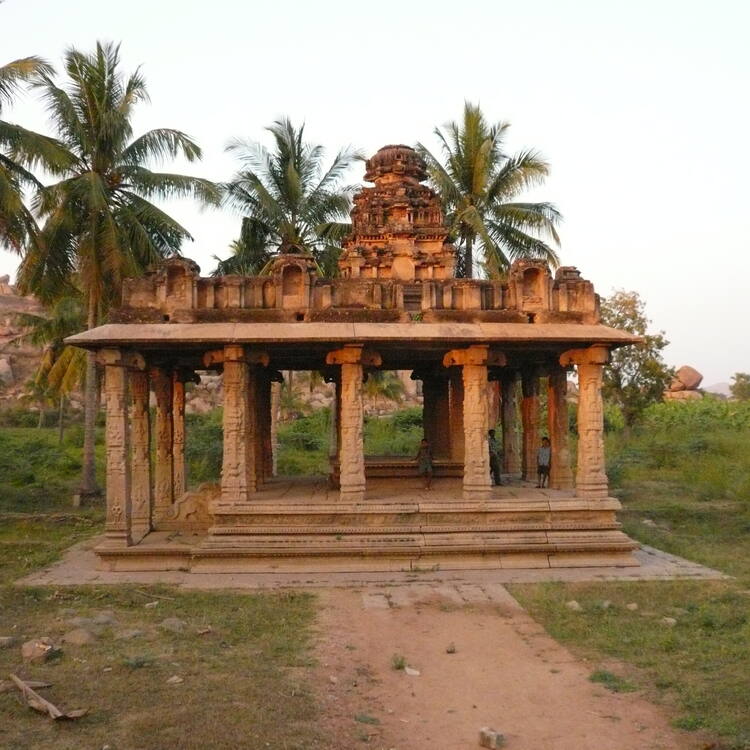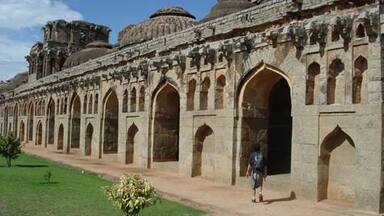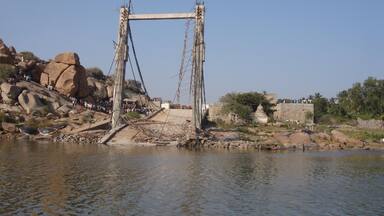Group of Monuments at Hampi
Group of Monuments at Hampi
The austere, grandiose site of Hampi was the last capital of the last great Hindu Kingdom of Vijayanagar. Its fabulously rich princes built Dravidian temples and palaces which won the admiration of travellers between the 14th and 16th centuries. Conquered by the Deccan Muslim confederacy in 1565, the city was pillaged over a period of six months before being abandoned.
Description is available under license CC-BY-SA IGO 3.0
Ensemble monumental de Hampi
Hampi est le site, austère et grandiose, de la dernière capitale du dernier grand royaume hindou de Vijayanagar, dont les princes extrêmement riches firent édifier des temples dravidiens et des palais qui firent l'admiration des voyageurs entre le XIVe et le XVIe siècle. Conquise par la Confédération islamique du Deccan en 1565, la ville fut livrée au pillage pendant six mois, puis abandonnée.
Description is available under license CC-BY-SA IGO 3.0
مجمّع النصب في هامبي
هامبي هو الموقع المُهيب والفخم لآخر عاصمة للمملكة الهندوسية الكبيرة الأخيرة فيجايانجار التي شيّد فيها الأمراء الأثرياء معابد دراويدية وقصوراً كانت محطّ إعجاب المسافرين بين القرن الرابع عشر والقرن السادس عشر. وبعدما هاجمها الاتحاد الإسلامي من دِكان عام 1565 تعرضت المدينة للسلب والنهب لفترة ستة أشهر ثم تركت.
source: UNESCO/CPE
Description is available under license CC-BY-SA IGO 3.0
汉皮古迹群
宏伟庄严的汉皮遗址是印度最后一个王朝查耶那加尔帝国最后的首都。14世纪至16世纪期间,富可敌国的王子们建造许多德拉威庙宇和富丽堂皇的宫殿,它们至今仍吸引着世界各地的旅行者。1565年亨比被穆斯林攻占,抢掠达6个月之久,最终城市被洗劫一空,毁于一旦。
source: UNESCO/CPE
Description is available under license CC-BY-SA IGO 3.0
Памятники Хампи
Величественный комплекс Хампи был последней столицей последнего великого индуистского государства – Виджаянагар. Его сказочно богатые правители воздвигли дравидские храмы и дворцы, которые вызывали восхищение путешественников в XIV-XVI вв. Завоеванный в 1565 г. союзом мусульман Декана, город был отдан на разграбление в течение шести месяцев, а затем заброшен.
source: UNESCO/CPE
Description is available under license CC-BY-SA IGO 3.0
Conjunto monumental de Hampi
Sitio austero y grandioso a la vez, Hampi fue el lugar donde estaba emplazada la capital del último gran reino hindú gobernado por la dinastía de los Vijayanagar. Estos soberanos, fabulosamente ricos, hicieron edificar templos dravidianos y palacios que causaron la admiración de los viajeros acudidos de todas partes entre los siglos XIV y XVI. Conquistada por la Confederación Islámica del Decán en 1565, la ciudad fue entregada al saqueo durante seis meses y luego fue abandonada.
source: UNESCO/CPE
Description is available under license CC-BY-SA IGO 3.0
ハンピの建造物群
インド南部、カルナータカ州東部の旧都。イスラム勢力の南下に抵抗して生まれた最後のヒンドゥ教王国・ヴィジャヤナガル朝は、14~15世紀にこの地に七重に城壁を巡らせた要害堅固な王都を築いた。16世紀中頃、ハンピはイスラム勢力の略奪と破壊にさらされ、やがて廃墟と化した。1981年「ハンピ再生計画」が立てられ、遺跡に残された5000に及ぶ碑文を手がかりに、王宮跡と寺院群からなる遺跡全体の修復に努めている。source: NFUAJ
Monumentengroep van Hampi
De monumenten in Hampi vormen de (restanten van de) laatste hoofdstad van het laatste grote Hindoe Koninkrijk Vijayanagar. De fabelachtig rijke prinsen bouwden Dravidische tempels en paleizen die de bewondering won van reizigers tussen de 14e en 16e eeuw. In 1565 werd de stad veroverd door de Deccan islamitische confederatie en zes maanden lang geplunderd, om daarna verlaten te worden. Hampi is een eerbetoon aan de verdwenen beschaving van het koninkrijk van Vijayanagar, die haar hoogtepunt bereikte onder het bewind van Krishna Deva Raya (1509-1530). Verrijkt door de katoenhandel en handel in specerijen was Hampi één van de mooiste steden van de middeleeuwse wereld.
Source: unesco.nl
हम्पी में स्मारकों का समूह
हम्पी का सादगीपूर्व भव्य स्थल विजयनगर के अंतिम महान हिंदू साम्राज्य की अंतिम राजधानी थी। इसके अत्यंत समृद्ध राजकुमारों ने द्रविड़ मंदिरों और महलों का निर्माण किया, जिनको 14वीं और 16वीं शताब्दी के बीच यात्रियों द्वारा अत्यंत प्रशंसा मिली। 1565 में डेक्कन मुस्लिम संघ द्वारा इस पर कब्जा कर लिया गया, उन्होंने शहर छोड़ने से पहले छह महीने तक वहां लूटपाट की।
Source: India
Outstanding Universal Value
Brief synthesis
The austere and grandiose site of Hampi comprise mainly the remnants of the Capital City of Vijayanagara Empire (14th-16th Cent CE), the last great Hindu Kingdom. The property encompasses an area of 4187, 24 hectares, located in the Tungabhadra basin in Central Karnataka, Bellary District.
Hampi’s spectacular setting is dominated by river Tungabhadra, craggy hill ranges and open plains, with widespread physical remains. The sophistication of the varied urban, royal and sacred systems is evident from the more than 1600 surviving remains that include forts, riverside features, royal and sacred complexes, temples, shrines, pillared halls, Mandapas, memorial structures, gateways, defence check posts, stables, water structures, etc.
Among these, the Krishna temple complex, Narasimha, Ganesa, Hemakuta group of temples, Achyutaraya temple complex, Vitthala temple complex, Pattabhirama temple complex, Lotus Mahal complex, can be highlighted. Suburban townships (puras) surrounded the large Dravidian temple complexes containing subsidiary shrines, bazaars, residential areas and tanks applying the unique hydraulic technologies and skilfully and harmoniously integrating the town and defence architecture with surrounding landscape. The remains unearthed in the site delineate both the extent of the economic prosperity and political status that once existed indicating a highly developed society.
Dravidian architecture flourished under the Vijayanagara Empire and its ultimate form is characterised by their massive dimensions, cloistered enclosures, and lofty towers over the entrances encased by decorated pillars.
The Vitthla temple is the most exquisitely ornate structure on the site and represents the culmination of Vijayanagara temple architecture. It is a fully developed temple with associated buildings like Kalyana Mandapa and Utsava Mandapa within a cloistered enclosure pierced with three entrance Gopurams. In addition to the typical spaces present in contemporary temples, it boasts of a Garuda shrine fashioned as a granite ratha and a grand bazaar street. This complex also has a large Pushkarani (stepped tank) with a Vasantotsava mandapa (ceremonial pavilion at the centre), wells and a network of water channels.
Another unique feature of temples at Hampi is the wide Chariot streets flanked by the rows of Pillared Mandapas, introduced when chariot festivals became an integral part of the rituals. The stone chariot in front of the temple is also testimony to its religious ritual. Most of the structures at Hampi are constructed from local granite, burnt bricks and lime mortar. The stone masonry and lantern roofed post and lintel system were the most favoured construction technique. The massive fortification walls have irregular cut size stones with paper joints by filling the core with rubble masonry without any binding material. The gopuras over the entrances and the sanctum proper have been constructed with stone and brick. The roofs have been laid with the heavy thick granite slabs covered with a water proof course of brick jelly and lime mortar.
Vijayanagara architecture is also known for its adoption of elements of Indo Islamic Architecture in secular buildings like the Queen’s Bath and the Elephant Stables, representing a highly evolved multi-religious and multi-ethnic society.Building activity in Hampi continued over a period of 200 years reflecting the evolution in the religious and political scenario as well as the advancements in art and architecture. The city rose to metropolitan proportions and is immortalized in the words of many foreign travellers as one of the most beautiful cities. The Battle of Talikota (1565 CE) led to a massive destruction of its physical fabric.
Dravidian architecture survives in the rest of Southern India spread through the patronage of the Vijayanagara rulers. The Raya Gopura, introduced first in the temples attributed to Raja Krishna Deva Raya, is a landmark all over South India.
Criterion (i): The remarkable integration between the planned and defended city of Hampi with its exemplary temple architecture and its spectacular natural setting represent a unique artistic creation.
Criterion (iii): The city bears exceptional testimony to the vanished civilization of the kingdom of Vijayanagara, which reached its apogee under the reign of Krishna Deva Raya (1509-1530).
Criterion (iv): This capital offers an outstanding example of a type of structure which illustrates a significant historical situation: that of the destruction of the Vijayanagara kingdom at the Battle of Talikota (1565 CE) which left behind an ensemble of living temples, magnificent archaeological remains in the form of elaborate sacred, royal, civil and military structures as well as traces of its rich lifestyle, all integrated within its natural setting.
Integrity
The area of the property is adequate to accommodate, represent and protect all the key attributes of the site.
The majority of the monuments are in good state of preservation and conservation. The highly developed and extremely sophisticated settlement articulates architectural manifestations, agricultural activities, irrigation systems, formal and informal paths, boulders and rocks, religious and social expressions. However, maintaining these conditions of integrity poses significant challenges derived mainly from pressures associated with development, planned and unplanned, which pose a threat to the landscape of the property, as well as encroachments and changes in land use, especially increased agricultural activity of commercial crops that might threaten the physical stability of the diverse monuments.
Particular attention will need to be placed on regulating residential constructions and potential development to accommodate visitor use, as well as infrastructure to address communication needs, particular by pass roads. Addressing also the visual impact of modern electrification fixtures, telephone poles and other elements, will also be important to maintain the integrity of the property.
Authenticity
The attributes like strategic location and abundance of natural resources, rendering this spectacular landscape befit for a Capital City have been maintained in the property.
The authenticity of the site has been maintained in terms of location and setting, as the original setting comprising of river Tungabhadra and boulders is fully retained. In terms of form and function, the integration of the geographic setting with man-made features in the design and functional layout of the entire capital can still be discerned and the form of the original city planning with suburban pattern is evident. The largely untouched archaeological elements provide ample evidences of authentic materials and construction and interventions have maintained qualities when undertaken. The stages of evolution and perfection of the Vijayanagara Architecture are evident in the monumental structures As for traditions and techniques; the physical remains are a befitting tribute to the ingenuity of the builders in shaping the metropolis of this grand scale by utilizing locally available material, traditional knowledge system and skilled craftsmanship. Today there is a continuity of several religious rituals, associations, traditional skills and occupations within the society that have been maintained.
However, the destruction by the battle of Talikota and the passage of time have led to some of the original functions and traditions becoming obsolete and altered, while several are in continuum forming an integral part of the site like festivals, temple rituals, pilgrimage, agriculture, etc. The Virupaksha temple is in constant worship, this has led to many additions and alterations to different parts of temple complex. Similarly, the haphazard growth of modern shops, restaurants in and around it and its bazaar that caters to religious and social tourists has impacted adversely on its setting as has the asphalting of the roads over the ancient pathway in front of the Virupaksha temple. The tensions between modern uses and protecting the fabric and setting of the ancient remains need to be managed with the utmost sensitivity.
Protection and management requirements
Different legal instruments exist for the protection of the property, including the Ancient Monuments and Archaeological Remains and Sites Act, 1958 (AMASR Act, 1958), AMASR (Amendment and Validation) Act, 2010 and Rules 1959 of the Government of India and Karnataka Ancient and Historical Monuments and Archaeological Sites and Remains Act, 1961. Recently, the Draft (Bill) of Hampi World Heritage Area Management Authority Act, 2001 has been framed to look after the protection and management of the 4187,24 hectares of the World Heritage Area.
There are different levels of authorities and agencies that have mandates that influence the protection and management of the property under a diversity of Acts. The Government of India, the Archaeological Survey of India (ASI) and the Government of Karnataka are responsible for the protection and management of fifty-six Nationally Protected Monuments and the rest of the area covered by 46.8 sq. kms respectively under their respective legal provisions. The ASI has established site office at Kamalapuram to manage the Centrally Protected Monuments. It is also functioning as World Heritage Site Co-ordinator at the local level and district level interacting with various local self Government and district authorities and the Hampi Development Authority for preserving the values of the property. The regional level office at Bangalore, which co-ordinates with Directorate, ASI, New Delhi and concerned agencies of the Government of Karnataka at higher level, supports the ASI site office at Kamalapur.
Office of the Director General, ASI, New Delhi office is a national apex body coordinating with UNESCO on one hand and the regional offices under whose jurisdiction the World Heritage Property falls and also the highest authorities of the Government of Karnataka on the other. The DAM has its office at Mysore and local office at Hampi. The HUDA, HWHAMA, Town Planning and other district level authorities are located in Hospet and Bellary, which is also the Head Quarters of the Deputy Commissioner. The management of other aspects of the property such as the cultural landscape, living traditions, rest with State, Town, Municipal and Village level agencies.
The constitution of a single heritage authority, Hampi World Heritage Area Management Authority (HWHAMA) ensure the effectiveness of the management system and coordination of works from different agencies while allowing local self Government authorities to continue to exercise the powers as enlisted in the respective Acts. The final powers for approving and regulating any developmental activities in the property rest with the HWHAMA. The establishment of the Integrated Information Management Centre and initiation of the Joint Heritage Management Program are major steps towards effective protection and management within the Indian legal frame work.
The present perspective acknowledges its diverse attributes and complex cultural systems. The management framework visualizes the site in its entirety where heritage management is the first priority followed by human resource development, which elevates the economic status. The implementation of the Integrated Management Plan aims at value-based management and ensures safeguarding of the outstanding universal value of the property.
Specific long, mid and short term goals for ensuring effective management of the property have been identified and their implementation processes are in various stages. The periodic review and update of management tools including the Master Plan, the Base Map on the GIS platform, the Conservation Plan, the Risk Preparedness Plan, the Public Use plan, and other tools to ensure sustainable development of the local community and also reduce the risk from natural and human made disaster in different areas of the property, is critical to ensure the sustainability of the management system. Long-term goals include internal capacity building and adoption of a new systematic approach where actions are coordinated and participatory. Sustained funding will be essential to ensure an operational system and the allocation of resources for the implementation of projects for the conservation and management of the diverse elements of the property.


